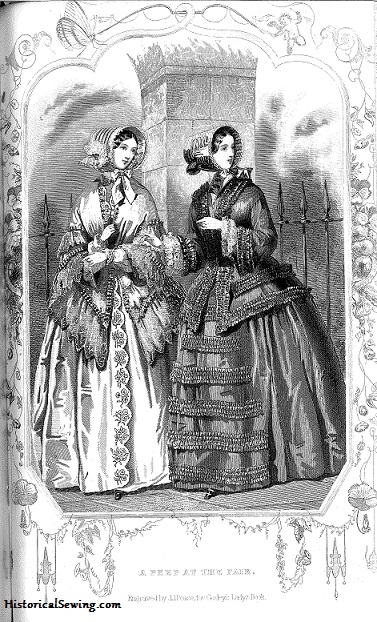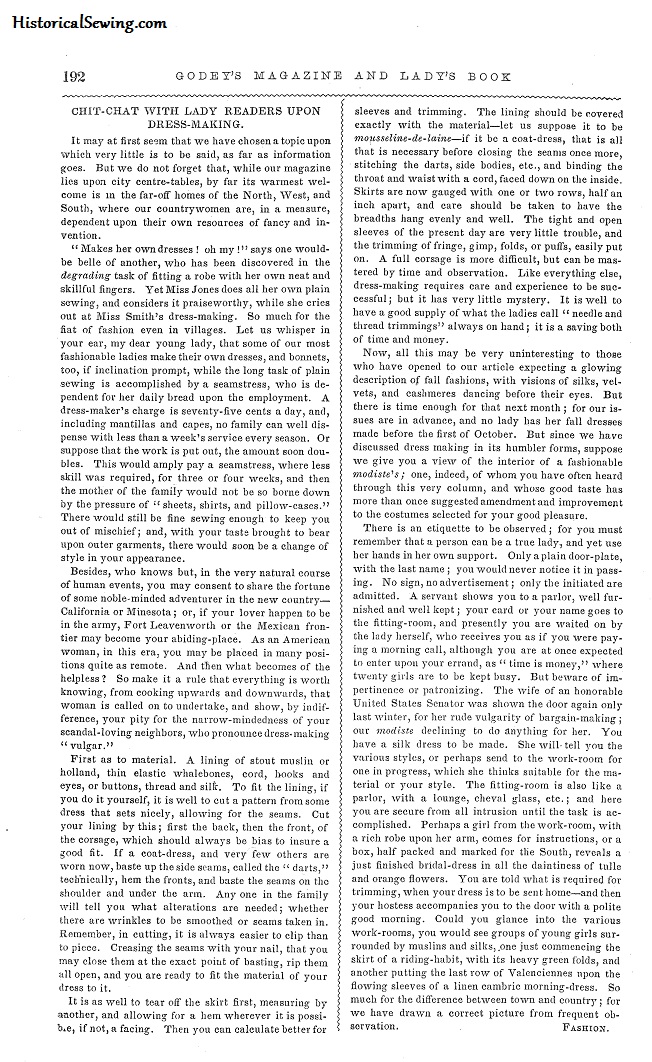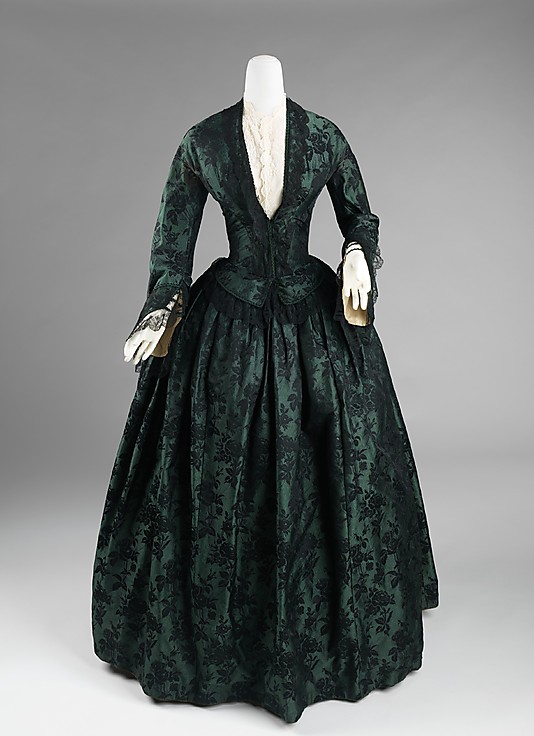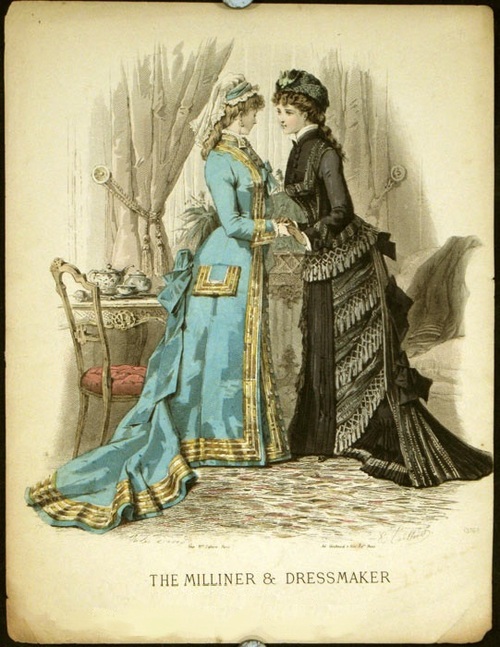
Contemporary periodicals written in the past are such wonderful original sources we can pull from when researching costumes! Written by those who actually made and wore the clothing we so romanticize and re-create, these articles inspire and give us a glimpse into their world.
I want to share with you a particular article about dressmaking – those who do so themselves and those who sew for others.
Quite lengthy (as most articles were back then due to no TV or internet distractions), it covers general thoughts, fabrics, sewing & fitting tips and etiquette in offering your sewing services to others, Victorian style.
Here is CHIT-CHAT WITH LADY READERS UPON DRESS-MAKING, Godey’s Lady’s Book, September 1851, most likely written by the editor, Sarah Josepha Hale. (Paragraphs are divided for easier online reading – how modern!).

It may at first seem that we have chosen a topic upon which very little is to be said, as far as information goes. But we do not forget that, while our magazine lies upon city centre-tables, by far its warmest welcome is in the far-off homes of the North, West, and South, where our countrywomen are, in a measure, dependent upon their own resources of fancy and invention.
“Makes her own dresses! oh my!” says one would-be belle of another, who has been discovered in the degrading task of fitting a robe with her own neat and skillful fingers. Yet Miss Jones does all her own plain sewing, and considers it praiseworthy, while she cries out at Miss Smith’s dress-making.
So much for the fiat of fashion even in villages. Let us whisper in your ear, my dear young lady, that some of our most fashionable ladies make their own dresses, and bonnets, too, if inclination prompt, while the long task of plain sewing is accomplished by a seamstress, who is dependent for her daily bread upon the employment.
A dress-maker’s charge is seventy-five cents a day, and, including mantillas and capes, no family can well dispense with less than a week’s service every season. Or suppose that the work is put out, the amount soon doubles.
This would amply pay a seamstress, where less skill was required, for three or four weeks, and then the mother of the family would not be so borne down by the pressure of “sheets, shirts, and pillow-cases.” There would still be fine sewing enough to keep you out of mischief; and, with your taste brought to bear upon outer garments, there would soon be a change of style in your appearance.
Besides, who knows but, in the very natural course of human events, you may consent to share the fortune of some noble-minded adventurer in the new country – California or Minesota; or, if your lover happen to be in the army, Fort Leavenworth or the Mexican frontier may become your abiding-place.
As an American woman, in this era, you may be placed in many positions quite as remote. And then what becomes of the helpless?
So make it a rule that everything is worth knowing, from cooking upwards and downwards, that woman is called on to undertake, and show, by indifference, your pity for the narrow-mindedness of your scandal-loving neighbors, who pronounce dress-making “vulgar.”

First as to material. A lining of stout muslin or Holland, thin elastic whalebones, cord, hooks and eyes, or buttons, thread and silk. To fit the lining, if you do it yourself, it is well to cut a pattern from some dress that sets nicely, allowing for the seams.
Cut your lining by this; first the back, then the front, of the corsage, which should always be bias to insure a good fit. If a coat-dress, and very few others are worn now, baste up the side seams, called the “darts,” technically, hem the fronts, and baste the seams on the shoulder and under the arm.
Any one in the family will tell you what alterations are needed; whether there are wrinkles to be smoothed or seams taken in. Remember, in cutting, it is always easier to clip than to piece. Creasing the seams with your nail, that you may close them at the exact point of basting, rip them all open, and you are ready to fit the material of your dress to it.
It is well to tear off the skirt first, measuring by another, and allowing for a hem wherever it is possible, if not, a facing. Then you can calculate better for sleeves and trimming.
The lining should be covered exactly with the material – let us suppose it to be mousseline-de-laine – if it be a coat-dress, that is all that is necessary before closing the seams once more, stitching the darts, side bodies, etc., and binding the throat and waist with a cord, faced down on the inside.

Skirts are now gauged with one or two rows, half an inch apart, and care should be taken to have the breadths hang evenly and well. The tight and open sleeves of the present day are very little trouble, and the trimming of fringe, gimp, folds, or puffs, easily put on.
A full corsage is more difficult, but can be mastered by time and observation. Like everything else, dress-making requires care and experience to be successful; but it has very little mystery. It is well to have a good supply of what the ladies call “needle and thread trimmings” always on hand; it is a saving both of time and money.
Now, all this may be very uninteresting to those who have opened to our article expecting a glowing description of fall fashion, with visions of silks, velvets, and cashmeres dancing before their eyes. But there is time enough for that next month; for our issues are in advance, and no lady has her fall dresses made before the first of October.
But since we have discussed dress making in its humbler forms, suppose we give you a view of the interior of a fashionable modiste’s; one, indeed, of whom you have often heard more than once suggested amendment and improvement to the costumes selected for your good pleasure.
There is an etiquette to be observed; for you must remember that a person can be a true lady, and yet use her hands in her own support. Only a plain door-plate, with the last name; you would never notice it in passing. No sign, no advertisement; only the initiated are admitted.
A servant shows you to a parlor, well furnished and well kept; your card or your name goes to the fitting-room, and presently you are waited on my the lady yourself, who receives you as if you were paying a morning call, although you are at once expected to enter upon your errand, as “time is money,” where twenty girls are to be kept busy.
But beware of impertinence or patronizing. The wife of an honorable United States Senator was shown the door again only last winter, for her rude vulgarity of bargain-making; our modiste declining to do anything for her.
You have a silk dress to be made. She will tell you the various styles, or perhaps send to the work-room for one in progress, which she thinks suitable for the material or your style. The fitting-room is also like a parlor, with a lounge, cheval glass, etc.; and here you are secure from all intrusion until the task is accomplished.
Perhaps a girl from the work-room, with a rich robe upon her arm, comes for instructions, or a box, half packed and marked for the South, reveals a just finished bridal-dress in all the daintiness of tulle and orange flowers.
You are told what is required for trimming, when your dress is to be sent home – and then your hostess accompanies you to the door with a polite good morning.

Could you glance into the various work-rooms, you would see groups of young girls surrounded by muslins and silks, one just commencing the skirt of a riding-habit, with its heavy green folds, and another putting the last row of Valenciennes upon the flowing sleeves of a linen cambric morning-dress.
So much for the difference between town and country; for we have drawn a correct picture from frequent observation. Fashion.
Wasn’t this delightful reading? Did you notice she called them “costumes?” And that skirts are cartridge pleated at the waist? Fun, yes? 🙂

One thing this article drives home is that everyday household linens were also homemade — and sheets, tablecloths, &c. require a LOT of seaming and hemming!
The article is delightful. I almost felt as if I were transported into the seamstress’ parlor and made aware of the good manners expected of me.
I love the “rule” that everything is worth knowing. My new motto!
Fascinating info! The wages of 75 cents/day is very useful to gauge pay for women vs. men at the time. Thank you for sharing this!!